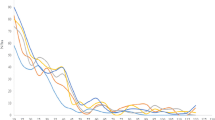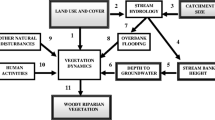Abstract
Riparian trees and shrubs are important providers of shade, bank stability, and woody debris needed for optimal stream quality and fish habitat in the coastal mountains of Oregon, but more data are needed to relate this woody vegetation to environmental variables. Trees, shrubs, and forest regeneration were studied in 22 riparian environments to provide those data. Conifer basal area increased with elevation, stream gradient, time since disturbance, and distance from the stream; it decreased with stream width. Salmonberry (Rubus spectabilis Pursh) cover and stink currant (Ribes bracteosum Dougl. ex Hook.) cover were highest near the streams. Dwarf Oregon grape (Berberis nervosa Pursh) cover and salal (Gaultheria shallon Pursh) cover were lowest near the streams. Although forest regeneration was poor everywhere, it decreased with total shrub cover and increased with stream gradient. Existing riparian conifer stands should be maintained wherever a continuing supply of coarse woody debris is required.
Similar content being viewed by others
References
Andrus C. and Froehlich H. A. 1988. Riparian forest development after logging or fire in the Oregon Coast Range: wildlife habitat and timber value, pp. 139–152. In: Symposium on Streamside management: Riparian Wildlife and Forestry Interactions. Univ. of Washington, Seattle.
Anthony R. G., Meslow E. C. and DeCalesta D. S. 1987. The role of riparian zones for wildlife in westside Oregon forests — what we know and don't know. National Council of the Paper Industry for Air and Stream Improvement. Tech. Bull. 514: 5–12.
Bunnell F. L. 1990. Reproduction of salal (Gaultheria shallon) under forest canopy. Can.J. For.Res. 20: 91–106.
Henderson J. A. 1978. Plant succession on the Alnus rubra/Rubus spectabilis habitat type in western Oregon. Northwest Science 52: 156–167.
Hibbs D. E. 1987. Management of riparian zone vegetation in western Oregon. National Council of the Paper Industry for Air and Stream Improvement. Tech. Bull. 514: 57–63.
Lienkaemper G. W. and Swanson F. J. 1987. Dynamics of large woody debris in streams in old-growth Douglas-fir forests. Can.J.For.Res. 17: 150–156.
Meehan, W. R., Swanson, F. J. and Sedell, J. R. 1977. Influences of riparian vegetation on aquatic ecosystems with particular reference to salmonid fishes and their food supply, pp. 137–145. In: Importance, Preservation and Management of Riparian Habitat: A Symposium. Coordinated by R. R. Johnson and D. A. Jones. USDA For. Serv., Gen. Tech. Rep. RM-43.
Minore, D. 1968. Effects of artificial flooding on seedling survival and growth of six northwestern tree species. USDA For. Serv., Res. Note PNW-92. 12pp.
Minore, D. 1970. Seedling growth of eight northwestern tree species over three water tables. USDA For. Serv., Res. Note PNW-115. 8 pp.
Minore, D. 1971. Occurrence and growth of four northwestern tree species over shallow water tables. USDA For. Serv., Res. Note PNW-160. 9 pp.
Robison E. G. and Beschta R. L. 1990. Identifying trees in riparian areas that can provide woody debris to streams. For. Sci. 36: 790–801.
Sedell, J. R., Bisson, P. A., Swanson, F. J. and Gregory, S. V. 1988. What we know about large trees that fall into streams and rivers, pp. 47–81. In: Maser, C., Tarrant, R. F., Trappe, J. M. and Franklin, J. F. (Eds) From the Forest to the Sea: A Story of Fallen Trees. USDA For. Serv., Gen. Tech. REp. RM-43.
Swanson, F. J. and Lienkaemper, G. W. 1978. Physical consequences of large organic debris in Pacific Northwest streams. USDA For. Serv., Gen. Tech. Rep. PNW-69. 12 pp.
Swanson, F. J., Lienkaemper, G. W. and Sedell, J. R. 1976. History, physical effects, and management implications of large organic debris in western Oregon streams. USDA For. Serv., Gen. Tech. Rep. PNW-56. 15 pp.
Tappeiner J. C., Zasada J. C., Ryan P. and Newton M. 1991. Salmonberry clonal and population structure: the basis for a persistent cover. Ecology 72: 609–618.
Author information
Authors and Affiliations
Rights and permissions
About this article
Cite this article
Minore, D., Weatherly, H.G. Riparian trees, shrubs, and forest regeneration in the coastal mountains of Oregon. New Forest 8, 249–263 (1994). https://doi.org/10.1007/BF00025371
Received:
Accepted:
Issue Date:
DOI: https://doi.org/10.1007/BF00025371




